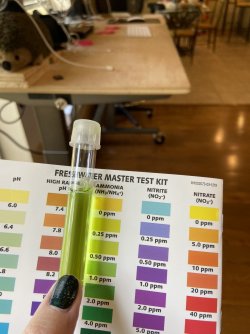KH and GH can be measured in ppm (parts per million), which is also the same as mg/L (milligrams per litre), or dGH/ dKH (degrees general hardness/ degrees karbonate hardness). The dGH/ dKH is the German scale for measuring hardness, whereas ppm is more American and English.
Note that carbonate hardness starts with a K in some test kits and a C for other test kits. That's nothing to worry about and just different languages writing the same word (Karbonate vs Carbonate).
1 dKH/ 1dGH = 17.9ppm.
---------------------
If you get a colour change after 3 drops in the KH test, the water has 3dKH (53.7ppm or 53.7 mg/L). Your KH is about 50ppm and is very low. KH is used to buffer the pH and stop it dropping. Most tanks need a KH above 5dKH (89.5ppm) to stop the pH dropping, however it depends on what species of fish and how many fish you have, tank size, water change schedule, etc.
If you get a colour change after 4 drops in the GH test, the water has 4dGH (71.6ppm or 71.6mg/L). Your GH is about 70ppm, which is quite soft and ideal for tetras, rasboras, gouramis, Bettas, angelfish and Corydoras catfish.
Fish like livebearers (mollies, guppies, platies, swordtails) need a pH above 7.0 and a GH above 200ppm. Mollies need the GH above 250ppm.
 . Is there an explanation on this anywhere please. TIA
. Is there an explanation on this anywhere please. TIA


